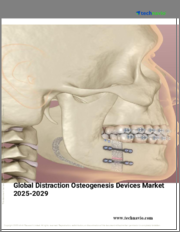
|
시장보고서
상품코드
1675366
골접합 디바이스 시장 : 유형별, 재료별, 골절 유형별, 최종사용자별, 지역별(2025-2033년)Osteosynthesis Devices Market by Type, Material, Fracture Type, End User, and Region 2025-2033 |
||||||
세계의 골접합 디바이스 시장 규모는 2024년에 103억 달러에 달했습니다. 향후 IMARC Group은 2033년에 174억 달러에 달하며, 2025-2033년의 성장률(CAGR)은 5.67%에 달할 것으로 예측하고 있습니다. 전 세계에서 교통사고가 증가하고 있는 것, 특히 고령자 사이에서 골절 및 골관절염의 유병률이 상승하고 있는 것이 시장을 촉진하는 주요 요인입니다.
골 접합(골유합술)은 여러 개의 이식 가능한 기구, 나사, 플레이트, 척추 고정장비, 척수강내 봉을 사용하여 골절된 다양한 뼈 조각을 접합하고 안정화시키는 것을 목적으로 하는 재건 정형외과수술입니다. 이 제품 유형에는 뼈 연장 기구, 일리자로프 기구, 와셔, 키르슈너 와이어(K-wire), 골절 고정 솔루션, 기타 의료용 임플란트 등이 포함되며, 수술에 일반적으로 사용되는 표준 내부 및 외부 제품 유형이 됩니다. 이들 부품은 마그네슘, 티타늄, 아연, 철, 금속 합금, 폴리머, 유리, 세라믹 등 분해성 및 비분해성 재료로 제조됩니다. 골접합 디바이스는 임플란트와 골다공증 뼈의 접촉면을 증가시키고, 뼈의 위치를 수정하고, 최적의 안정성을 제공하면서 손상을 치유하고, 더 나은 임상 결과를 초래하는 데 도움이 됩니다. 그 결과, 골접합 디바이스는 고관절, 대퇴골, 손, 손목, 쇄골, 견갑골, 슬개골, 비골 골절 치료에 사용되고 있습니다.
골접합 디바이스 시장 동향 :
세계에서 교통사고가 증가하고 있는 것은 시장 성장을 가속하는 주요 요인 중 하나입니다. 또한 특히 고령층에서 골절 및 골관절염의 유병률이 증가하고 있는 것도 시장 성장에 기여하고 있습니다. 이에 따라 뼈 수술에 대한 니즈 증가와 여러 가지 장점으로 인해 기존 수술보다 최소침습적 수술에 대한 소비자의 선호도 변화가 또 다른 성장 촉진요인으로 작용하고 있습니다. 이는 주로 최소침습 수술이 더 나은 결과를 달성하는 데 도움이 되고, 감염의 위험을 줄이고, 대규모 출혈을 피하고, 절개로 인한 피부와 조직을 완화하고, 더 나은 임상 결과를 제공하기 때문입니다. 또한 다양한 신체 부위에 맞는 다양한 골접합 디바이스를 제조하기 위해 많은 국가의 정부가 생물 의학 기업에 투자하는 유리한 구상을 시행하고 있는 것도 시장 성장을 지원하고 있습니다. 또한 플레이트, 로드, 와이어, 핀, 스크류를 제조하기 위해 생체 적합성 및 생체흡수성 재료가 널리 사용되고 있는 것도 시장 성장을 가속하고 있습니다. 이러한 부품은 뼈 접합 장비를 제거할 필요가 없고, 뼈의 치유 속도를 높이는 등 다양한 이점을 제공합니다. 의료 인프라의 대폭적인 강화와 골접합 디바이스의 효과를 높이기 위한 의학 분야의 지속적인 연구개발(R&D) 활동과 같은 다른 요인들도 시장 전망을 밝게 하고 있습니다.
이 보고서에서 다룬 주요 질문
- 세계 골접합 디바이스 시장은 지금까지 어떻게 성장해왔고, 앞으로 어떻게 변화하는가?
- 세계 골접합 디바이스 시장에서의 촉진요인, 억제요인, 기회는?
- 주요 지역 시장은?
- 가장 매력적인 골접합 디바이스 시장은 어느 국가인가?
- 유형별 시장 분석은?
- 재료별 시장 현황은?
- 골절 유형별 시장 분석은?
- 최종사용자별 시장 분석은?
- 세계 골접합 디바이스 시장의 경쟁 구도는?
- 세계 골접합 디바이스 시장의 주요 기업은?
목차
제1장 서문
제2장 조사 범위와 조사 방법
- 조사의 목적
- 이해관계자
- 데이터 소스
- 1차 정보
- 2차 정보
- 시장 추정
- 보텀업 어프로치
- 톱다운 어프로치
- 조사 방법
제3장 개요
제4장 서론
- 개요
- 주요 업계 동향
제5장 세계의 골접합 디바이스 시장
- 시장 개요
- 시장 실적
- COVID-19의 영향
- 시장 예측
제6장 시장 내역 : 유형별
- 내부
- 주요 부문
- 나사와 플레이트
- 와이어와 핀
- 골수내 로드와 못
- 척추 고정기구
- 주요 부문
- 외부
- 주요 부문
- 골절 고정
- 뼈 연장
- 주요 부문
제7장 시장 내역 : 재료별
- 분해 불가능
- 분해 가능
제8장 시장 내역 : 골절 유형별
- 슬개골, 경골, 종아리뼈, 발목
- 쇄골, 견갑골, 상완골
- 요골 또는 척골
- 손, 손목
- 척주
- 골반
- 고관절
- 대퇴골
- 발뼈
- 기타
제9장 시장 내역 : 최종사용자별
- 병원
- 정형외과 전문 클리닉
- 기타
제10장 시장 내역 : 지역별
- 북미
- 미국
- 캐나다
- 아시아태평양
- 중국
- 일본
- 인도
- 한국
- 호주
- 인도네시아
- 기타
- 유럽
- 독일
- 프랑스
- 영국
- 이탈리아
- 스페인
- 러시아
- 기타
- 라틴아메리카
- 브라질
- 멕시코
- 기타
- 중동 및 아프리카
- 시장 내역 : 국가별
제11장 촉진요인·억제요인·기회
- 개요
- 촉진요인
- 억제요인
- 기회
제12장 밸류체인 분석
제13장 Porter's Five Forces 분석
- 개요
- 바이어의 교섭력
- 공급 기업의 교섭력
- 경쟁의 정도
- 신규 진출업체의 위협
- 대체품의 위협
제14장 가격 분석
제15장 경쟁 구도
- 시장 구조
- 주요 기업
- 주요 기업의 개요
- Arthrex Inc.
- B. Braun Melsungen AG
- Globus Medical Inc.
- GS Medical USA
- Johnson & Johnson
- Life Spine Inc.
- MicroPort Scientific Corporation
- Neosteo SAS
- Precision Spine Inc.
- Smith & Nephew plc
- Stryker Corporation
- Zimmer Biomet
The global osteosynthesis devices market size reached USD 10.3 Billion in 2024. Looking forward, IMARC Group expects the market to reach USD 17.4 Billion by 2033, exhibiting a growth rate (CAGR) of 5.67% during 2025-2033. The increasing incidences of road accidents across the globe and the rising prevalence of bone fractures and osteoarthritis, especially amongst the geriatric population, represent some of the key factors driving the market.
Osteosynthesis represents a reconstructive orthopedic surgical procedure intended to join and stabilize various broken and fractured bone fragments by using multiple implantable devices, screws, plates, spinal fixations, and intramedullary rods. It encompasses bone lengthening and Ilizarov devices, washers, Kirschner wires (K-wires), fracture fixation solutions, and other medical implants as standard internal and external product types that are commonly used in surgeries. These components are manufactured from several degradable and non-degradable materials, including magnesium, titanium, zinc, iron, metallic alloys, polymers, glasses, and ceramics. Osteosynthesis devices aid in increasing the contact surface between the implants and osteoporotic bone, correcting the bone position, and healing the damages while providing optimal stability and providing better clinical outcomes. As a result, osteosynthesis devices are used in the treatment of hip, femur, hand, wrist, clavicle, scapula, patella, and fibula fractures.
Osteosynthesis Devices Market Trends:
The increasing incidences of road accidents across the globe represents one of the primary factors driving the market growth. Moreover, the rising prevalence of bone fractures and osteoarthritis, especially amongst the geriatric population is contributing to the market growth. In line with this, the rising need for bone surgeries and the shifting consumer inclination toward minimally invasive operations over full-fledged surgical procedures due to their multiple benefits are acting as another growth-inducing factor. This is primarily because minimally invasive surgeries help achieve better results, reduce the risk of infection, avoid large-scale blood loss, mitigate skin and tissues caused by incisions and offer better clinical outcomes. Additionally, the favorable initiatives being implemented by governments of numerous countries to invest in biomedical companies for manufacturing several osteosynthesis devices for diverse body parts are supporting the market growth. Furthermore, the extensive utilization of biocompatible and bioabsorbable materials to fabricate plates, rods, wires, pins, and screws is favoring the market growth. These components offer various advantages, including eliminating the need to remove osteosynthesis devices and ensuring faster bone healing. Other factors, such as significant enhancements in the healthcare infrastructures and the continuous research and development (R&D) activities in the field of medical sciences to enhance the efficacy of osteosynthesis devices, are creating a positive outlook for the market.
Key Market Segmentation:
Type Insights:
- Internal
- Screw and Plates
- Wires and Pins
- Intramedullary Rods and Nails
- Spinal Fixation Devices
- External
- Fracture Fixation
- Bone Lengthening
- The report has also provided a detailed breakup and analysis of the osteosynthesis devices market based on the type. This includes internal (screws and plates, wires and pins, intramedullary rods and nails, and spinal fixation devices) and external (fracture fixation and bone lengthening). According to the report, internal represented the largest segment.
Material Insights:
- Non-Degradable
- Degradable
Fracture Type Insights:
- Patella, Tibia or Fibula or Ankle
- Clavicle, Scapula or Humerus
- Radius or Ulna
- Hand, Wrist
- Vertebral Column
- Pelvis
- Hip
- Femur
- Foot Bones
- Others
- The report has also provided a detailed breakup and analysis of the osteosynthesis devices market based on the fracture type. This includes patella, tibia or fibula or ankle, clavicle, scapula or humerus, radius or ulna, hand, wrist, vertebral column, pelvis, hip, femur, foot bones, and others. According to the report, patella, tibia or fibula or ankle represented the largest segment.
End User Insights:
- Hospitals
- Orthopedic Specialist Clinics
- Others
Regional Insights:
- North America
- United States
- Canada
- Asia Pacific
- China
- Japan
- India
- South Korea
- Australia
- Indonesia
- Others
- Europe
- Germany
- France
- United Kingdom
- Italy
- Spain
- Russia
- Others
- Latin America
- Brazil
- Mexico
- Others
- Middle East and Africa
- The report has also provided a comprehensive analysis of all the major regional markets that include North America (the United States and Canada); Asia Pacific (China, Japan, India, South Korea, Australia, Indonesia, and others); Europe (Germany, France, the United Kingdom, Italy, Spain, Russia, and others); Latin America (Brazil, Mexico, and others); and the Middle East and Africa. According to the report, North America was the largest market for osteosynthesis devices. Some of the factors driving the North America osteosynthesis devices market included the increasing incidences of road accidents, the rising prevalence of bone fractures and osteoarthritis, and the growing geriatric population across the globe.
Competitive Landscape:
- The report has also provided a comprehensive analysis of the competitive landscape in the global osteosynthesis devices market. Detailed profiles of all major companies have also been provided. Some of the companies covered include Arthrex Inc., B. Braun Melsungen AG, Globus Medical Inc., GS Medical USA, Johnson & Johnson, Life Spine Inc., MicroPort Scientific Corporation, Neosteo SAS, Precision Spine Inc., Smith & Nephew plc, Stryker Corporation, Zimmer Biomet, etc.
Key Questions Answered in This Report:
- How has the global osteosynthesis devices market performed so far and how will it perform in the coming years?
- What are the drivers, restraints, and opportunities in the global osteosynthesis devices market?
- What are the key regional markets?
- Which countries represent the most attractive osteosynthesis devices markets?
- What is the breakup of the market based on the type?
- What is the breakup of the market based on the material?
- What is the breakup of the market based on the fracture type?
- What is the breakup of the market based on the end user?
- What is the competitive structure of the global osteosynthesis devices market?
- Who are the key players/companies in the global osteosynthesis devices market?
Table of Contents
1 Preface
2 Scope and Methodology
- 2.1 Objectives of the Study
- 2.2 Stakeholders
- 2.3 Data Sources
- 2.3.1 Primary Sources
- 2.3.2 Secondary Sources
- 2.4 Market Estimation
- 2.4.1 Bottom-Up Approach
- 2.4.2 Top-Down Approach
- 2.5 Forecasting Methodology
3 Executive Summary
4 Introduction
- 4.1 Overview
- 4.2 Key Industry Trends
5 Global Osteosynthesis Devices Market
- 5.1 Market Overview
- 5.2 Market Performance
- 5.3 Impact of COVID-19
- 5.4 Market Forecast
6 Market Breakup by Type
- 6.1 Internal
- 6.1.1 Market Trends
- 6.1.2 Key Segments
- 6.1.2.1 Screws and Plates
- 6.1.2.2 Wires and Pins
- 6.1.2.3 Intramedullary Rods and Nails
- 6.1.2.4 Spinal Fixation Devices
- 6.1.3 Market Forecast
- 6.2 External
- 6.2.1 Market Trends
- 6.2.2 Key Segments
- 6.2.2.1 Fracture Fixation
- 6.2.2.2 Bone Lengthening
- 6.2.3 Market Forecast
7 Market Breakup by Material
- 7.1 Non-Degradable
- 7.1.1 Market Trends
- 7.1.2 Market Forecast
- 7.2 Degradable
- 7.2.1 Market Trends
- 7.2.2 Market Forecast
8 Market Breakup by Fracture Type
- 8.1 Patella, Tibia or Fibula or Ankle
- 8.1.1 Market Trends
- 8.1.2 Market Forecast
- 8.2 Clavicle, Scapula or Humerus
- 8.2.1 Market Trends
- 8.2.2 Market Forecast
- 8.3 Radius or Ulna
- 8.3.1 Market Trends
- 8.3.2 Market Forecast
- 8.4 Hand, Wrist
- 8.4.1 Market Trends
- 8.4.2 Market Forecast
- 8.5 Vertebral Column
- 8.5.1 Market Trends
- 8.5.2 Market Forecast
- 8.6 Pelvis
- 8.6.1 Market Trends
- 8.6.2 Market Forecast
- 8.7 Hip
- 8.7.1 Market Trends
- 8.7.2 Market Forecast
- 8.8 Femur
- 8.8.1 Market Trends
- 8.8.2 Market Forecast
- 8.9 Foot Bones
- 8.9.1 Market Trends
- 8.9.2 Market Forecast
- 8.10 Others
- 8.10.1 Market Trends
- 8.10.2 Market Forecast
9 Market Breakup by End User
- 9.1 Hospitals
- 9.1.1 Market Trends
- 9.1.2 Market Forecast
- 9.2 Orthopedic Specialist Clinics
- 9.2.1 Market Trends
- 9.2.2 Market Forecast
- 9.3 Others
- 9.3.1 Market Trends
- 9.3.2 Market Forecast
10 Market Breakup by Region
- 10.1 North America
- 10.1.1 United States
- 10.1.1.1 Market Trends
- 10.1.1.2 Market Forecast
- 10.1.2 Canada
- 10.1.2.1 Market Trends
- 10.1.2.2 Market Forecast
- 10.1.1 United States
- 10.2 Asia-Pacific
- 10.2.1 China
- 10.2.1.1 Market Trends
- 10.2.1.2 Market Forecast
- 10.2.2 Japan
- 10.2.2.1 Market Trends
- 10.2.2.2 Market Forecast
- 10.2.3 India
- 10.2.3.1 Market Trends
- 10.2.3.2 Market Forecast
- 10.2.4 South Korea
- 10.2.4.1 Market Trends
- 10.2.4.2 Market Forecast
- 10.2.5 Australia
- 10.2.5.1 Market Trends
- 10.2.5.2 Market Forecast
- 10.2.6 Indonesia
- 10.2.6.1 Market Trends
- 10.2.6.2 Market Forecast
- 10.2.7 Others
- 10.2.7.1 Market Trends
- 10.2.7.2 Market Forecast
- 10.2.1 China
- 10.3 Europe
- 10.3.1 Germany
- 10.3.1.1 Market Trends
- 10.3.1.2 Market Forecast
- 10.3.2 France
- 10.3.2.1 Market Trends
- 10.3.2.2 Market Forecast
- 10.3.3 United Kingdom
- 10.3.3.1 Market Trends
- 10.3.3.2 Market Forecast
- 10.3.4 Italy
- 10.3.4.1 Market Trends
- 10.3.4.2 Market Forecast
- 10.3.5 Spain
- 10.3.5.1 Market Trends
- 10.3.5.2 Market Forecast
- 10.3.6 Russia
- 10.3.6.1 Market Trends
- 10.3.6.2 Market Forecast
- 10.3.7 Others
- 10.3.7.1 Market Trends
- 10.3.7.2 Market Forecast
- 10.3.1 Germany
- 10.4 Latin America
- 10.4.1 Brazil
- 10.4.1.1 Market Trends
- 10.4.1.2 Market Forecast
- 10.4.2 Mexico
- 10.4.2.1 Market Trends
- 10.4.2.2 Market Forecast
- 10.4.3 Others
- 10.4.3.1 Market Trends
- 10.4.3.2 Market Forecast
- 10.4.1 Brazil
- 10.5 Middle East and Africa
- 10.5.1 Market Trends
- 10.5.2 Market Breakup by Country
- 10.5.3 Market Forecast
11 Drivers, Restraints, and Opportunities
- 11.1 Overview
- 11.2 Drivers
- 11.3 Restraints
- 11.4 Opportunities
12 Value Chain Analysis
13 Porters Five Forces Analysis
- 13.1 Overview
- 13.2 Bargaining Power of Buyers
- 13.3 Bargaining Power of Suppliers
- 13.4 Degree of Competition
- 13.5 Threat of New Entrants
- 13.6 Threat of Substitutes
14 Price Analysis
15 Competitive Landscape
- 15.1 Market Structure
- 15.2 Key Players
- 15.3 Profiles of Key Players
- 15.3.1 Arthrex Inc.
- 15.3.1.1 Company Overview
- 15.3.1.2 Product Portfolio
- 15.3.1.3 SWOT Analysis
- 15.3.2 B. Braun Melsungen AG
- 15.3.2.1 Company Overview
- 15.3.2.2 Product Portfolio
- 15.3.2.3 SWOT Analysis
- 15.3.3 Globus Medical Inc.
- 15.3.3.1 Company Overview
- 15.3.3.2 Product Portfolio
- 15.3.3.3 Financials
- 15.3.3.4 SWOT Analysis
- 15.3.4 GS Medical USA
- 15.3.4.1 Company Overview
- 15.3.4.2 Product Portfolio
- 15.3.5 Johnson & Johnson
- 15.3.5.1 Company Overview
- 15.3.5.2 Product Portfolio
- 15.3.5.3 Financials
- 15.3.5.4 SWOT Analysis
- 15.3.6 Life Spine Inc.
- 15.3.6.1 Company Overview
- 15.3.6.2 Product Portfolio
- 15.3.7 MicroPort Scientific Corporation
- 15.3.7.1 Company Overview
- 15.3.7.2 Product Portfolio
- 15.3.7.3 Financials
- 15.3.8 Neosteo SAS
- 15.3.8.1 Company Overview
- 15.3.8.2 Product Portfolio
- 15.3.9 Precision Spine Inc.
- 15.3.9.1 Company Overview
- 15.3.9.2 Product Portfolio
- 15.3.10 Smith & Nephew plc
- 15.3.10.1 Company Overview
- 15.3.10.2 Product Portfolio
- 15.3.10.3 Financials
- 15.3.10.4 SWOT Analysis
- 15.3.11 Stryker Corporation
- 15.3.11.1 Company Overview
- 15.3.11.2 Product Portfolio
- 15.3.11.3 Financials
- 15.3.11.4 SWOT Analysis
- 15.3.12 Zimmer Biomet
- 15.3.12.1 Company Overview
- 15.3.12.2 Product Portfolio
- 15.3.12.3 Financials
- 15.3.12.4 SWOT Analysis
- 15.3.1 Arthrex Inc.
Kindly note that this only represents a partial list of companies, and the complete list has been provided in the report.



















